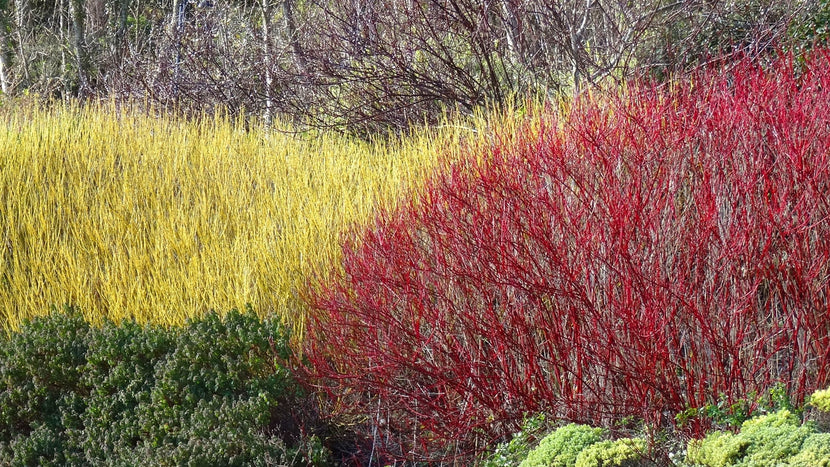Planting Dogwood Bushes in the Garden
Plant Guide

Few Plants offer the 4 season interest to the home garden, like Dogwood Bushes. The truth is Dogwood shrubs add color with their red or yellow winter stems and draw color to the garden in the form of butterflies and birds. Spring flowers attract pollinators which help the plant produce summer berries that the colorful birds adore each fall and winter. Planting Dogwood Shrubs is an investment that adds color to the garden from early spring through winter and in pollinators and colorful berry-loving songbirds.
Choosing the Best Location for Dogwood Bushes
When deciding where to plant dogwood bushes, here are a few things to consider:
Contrasting Backdrop: This is a concept that will give the most enjoyment to the gardener if understood and employed correctly. The most appealing feature of the dogwood family of shrubs is the red stems that shine in winter like no other plant. Red Twig dogwoods become a showpiece of the landscape when sited correctly.
Choose evergreen trees and shrubs that will maintain their foliage in winter. Try to site dogwood bushes so that they are planted in front of a dark-colored backdrop. This makes the colorful stems stand out and also can make the white flowers in early spring stand out. Alternately planting dogwoods at the base of a hill covered in snow during the winter also adds to the appeal in winter.
Keep in mind that some varieties of Dogwood bushes can get anywhere from 6 to 8 feet tall, so choose evergreens that grow to heights above the dogwood.
Another example of contrasting backdrops to enhance the dogwood is planting Cornus Ivory Halo Cornus Alba 'Ivory Halo' in front of a red brick wall or garden feature. The red color enhances the white-edged leaves creating a pleasing contrast to the plant.
Remember that, unlike dogwood trees, the flowering dogwood shrubs are fragrant. If possible, select a location that meets the above requirements but allows them to be close enough to outdoor living areas to enjoy the fragrance of these delightful shrubs.
Ground Rules

Light
Dogwood bushes prefer full sun to Part Sun locations. Growing dogwoods in too little direct sun cause them to stretch, giving them an open appearance. This makes the plants look unhealthy, and more often than not, the stem color is not as bright and vivid as it should be. Of all dogwood bushes, the Cornus sericea tolerates less sun than the other varieties and can be grown in part shade locations such as under larger shade trees.

Soil
Dogwood bushes thrive in consistently moist soils that are not extremely dry. One established they can tolerate less moisture but be ready to provide supplemental watering to the plants during periods of drought. Adding compost to the backfill soil can help to provide moisture-retentive soil for the dogwood.
Planting Process
- Once you've selected the location for your Dogwoods, planting is similar to planting most other shrubs or trees. Dig a planting hole that is wider than the pot the shrub has been grown in but be careful not to dig the hole deeper than the existing soil in the pot. If your existing soil does not contain high levels of organic matter, it is recommended to add compost sourced from your local garden center.
- Place the plant in the planting hole and firmly compact the enriched soil back around the rootball, being careful not to damage the roots in the process.
- Mulch the soil surrounding the new plant carefully with shredded hardwood mulch or pine needles to a depth of 2 inches. Keep a two-inch area around the base of the stem mulch free. When mulching, be careful not to allow the mulch to remain around the base of the plant, as this can cause disease.
- Water the newly planted shrub deeply when planting. Take care not to rush this process, as in the beginning, most of the water will run away unless you have created a soil ring around the outside of the planting hole. Water the plant every other day for the first two weeks after planting.During week three, you can start to reduce the frequency of water but not the volume. After thirty days, you should only need to water once per week except if planting in the summer when supplemental watering may need to be done bi-weekly.When watering, be careful to water the base of the plant. Watering the leaves can cause the foliage to remain wet for extended periods, which can cause unsightly leaf spots to form.
